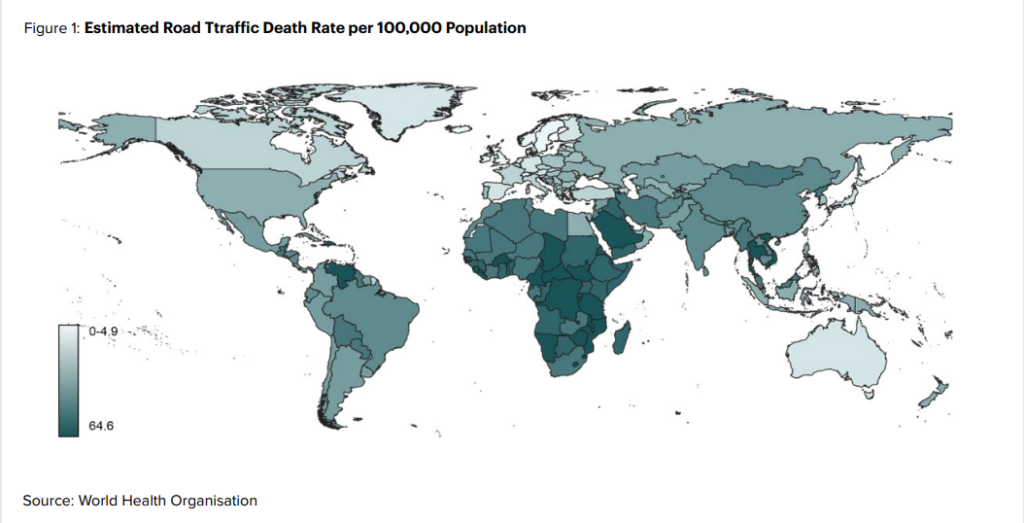Approximately 1.3 million people die each year as a result of road traffic accidents (RTAs). Some 93% of RTA related fatalities take place in low- and middle-income countries, even though these countries have approximately 60% of the world’s vehicles1. Among travel security risk managers, RTAs are the most commonly reported serious incident, which like any risk can be mitigated against. The section below will briefly run through pre-travel, during travel, and post-travel security risk management best practices with regards to private car hire usage for travellers on deployment.

Pre-Travel
Prior to any travel organised on behalf of an employee or client it is important to fulfil the following practical criteria which will help mitigate many typical road related safety and security risks.
Necessity:
- The most effective means of reducing travel risks is ‘avoiding’ the need to travel in the first place. Employees should be encouraged to evaluate any need to travel (for work) prior to requesting it. Can the work be done remotely? Can the other party come to you? Or, if an employee is already in-country, can the work be conducted in a conference room inside the hotel of stay? – Reducing the need to conduct a trip across a city for example.
Research:
- Potential travel locations must be researched and analysed in-depth. Understanding the huge range of political, economic, social, technological, legal, and environmental (PESTLE) issues and limitations that may impact ground travel at any given location, such
as protests, calendar events, potential flooding, etc. Alert:24’s inhouse Risk Advisory team can help your organisation identify, analyse, and mitigate against these. - Most travel on land requires travellers to travel by road, but PESTLE research may indicate that travel by road is not the safest and most secure means, and other viable options should be considered such as rail, water, or air.
- Quality and conditions of local roads should be researched. This includes understanding if roads are tarmac/dirt, typical traffic conditions, likelihood of road checkpoints, etc. Basic levels of research such as using satellite imagery, online travel vlogs, and anecdotal evidence from previous travellers or nationals can help attain an understanding of the ground transport that will be necessary – such as 4×4 capable vehicles.
- Pre-established routes to and from airport-hotel, hotel-meeting site, etc. must be investigated. Criminals may be known to target such routes. Known high risk neighbourhoods in and out of a city for example must be avoided. Protection or deterrence measures may be advised.
- Driving/taxi scams of the day for a particular location must be identified to best mitigate the risk of victimisation.
- Communications issues should be looked into. Some countries have a tendency to shut off the internet during periods of unrest; remote locations can have poor signal; geographic features can disrupt signal; all of which can unnecessarily trigger serious concerns of traveller wellbeing. Contingency comms plans should be considered.
Due Diligence:
- Drivers and vehicles used to transport employees need to be properly sourced. Booking highly reputable or recommended firms in the country of travel is good practice. High-end hotels will often have a list of drivers/firms that they have come to rely upon. Enquire with them to help organise transport to and from a hotel, and to provide driver/car details.
- If using a (recommended) private driver/freelancer, then it is prudent to request proof of a driving license, photos of their vehicle – interior and exterior – confirming their vehicle is up to the standards required for the trip. Always ensure the vehicle has seatbelts!
- Consider internationally reputable ride sharing apps such as Didi, Uber, etc. – which are relatively well accounted, provide vehicle/driver information ahead of a trip, allow for cashless pre-trip fare payment, and often include vehicles of a decent quality. Check they are available and recommended in the country of travel.
- Selected vehicles of travel should not stand out in local traffic.
Traveller Prep/Knowledge:
- Travellers must be made aware of relevant information discovered during the research phase.
- Travellers must be made aware of the risk management procedures they will be expected to comply with whilst on travel, such as fulfilling check-in schedules on time and only using suggested transport. No tuk-tuks!
- Travellers travelling in moderate to extreme risk countries are recommended to complete travel security courses such as first aid or Hostile Environment Awareness Training (HEAT).
- Any pre-travel concerns, or worst, any obvious complacency shown by the traveller must be managed before travel.
- If travellers are to be picked-up by a locally sourced driver, travellers should be fully aware of driver/vehicle details.
During Travel:
Whilst in-country, traveller(s) are responsible for following suggested risk mitigation advice.
Low Profile Car Travel:
- When being picked-up by a privately sourced driver, travellers must follow basic procedures of asking their driver to confirm their identification and location of drop-off destination.
- Travellers should always give any transport they intend to use a quick visual inspection, ensuring the car looks fit for travel and has working seatbelts. If conducting a long journey, insist on checking there is a suitable breakdown kit as well as a stocked first aid kit.
- Travellers should keep a close eye on their luggage upon arrival, including ensuring any luggage is placed inside the car’s trunk before getting inside the vehicle.
- Whenever possible, travellers should ride as a passenger in the back seat, ideally behind the driver’s seat.
- Avoid waiting on public streets whenever possible. When booking transport/taxi, travellers should stay inside until it has arrived.
- When inside a vehicle on the move, ensure all windows and doors are locked.
- If a driver is driving erratically/dangerously, travellers can try to communicate to the driver to drive slower, possibly indicating potential travel sickness – timing is important, taxi drivers have been known to instantly pull over in a dangerous manner/area.
- When exiting a vehicle, always exit from the pavement side.
- Always carry low denomination local currency to reduce the risk of exploitation/scams.
Post-Travel:
Following a traveller deployment, post-travel debriefs between a traveller and risk manager provide an opportunity to develop knowledge and review the quality of procured travel security services.
Debrief:
- Debriefs should be conducted as soon as possible upon traveller(s) return.
- Questions should be asked regarding traveller’s perspective on their safety and security during their trip, including any procured transport/drivers that were relied upon.
- Safety/security incidents and near misses should be logged. After action review feedback should be followed up.

Author
Carl Dobson – Head of Intelligence, Alert:24
Leading SCR and Alert:24’s Security Risk Analyst team, Carl oversees the intelligence and analytical elements to client services.
Carl served eight-years in the British Army Intelligence Corps prior to joining Alert:24 as an Operations Centre Consultant in June 2013. Progressing through the business and gaining corporate experience, he now manages our team of analysts, providing a wide range of Risk Advisory services to our diverse client base. Carl also has a BSc (Hons) in Design Technology.
- World Health Organisation, “Road traffic injuries”, June 20, 2022. https://www.who.int/news-room/fact-sheets/detail/road-traffic-injuries ↩︎